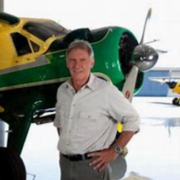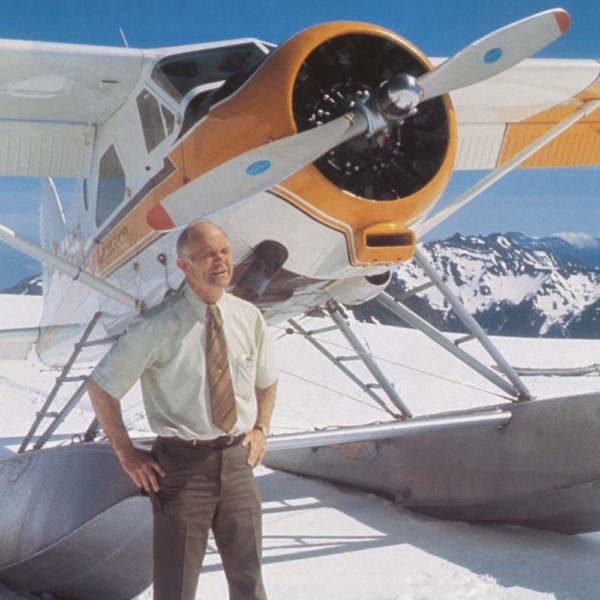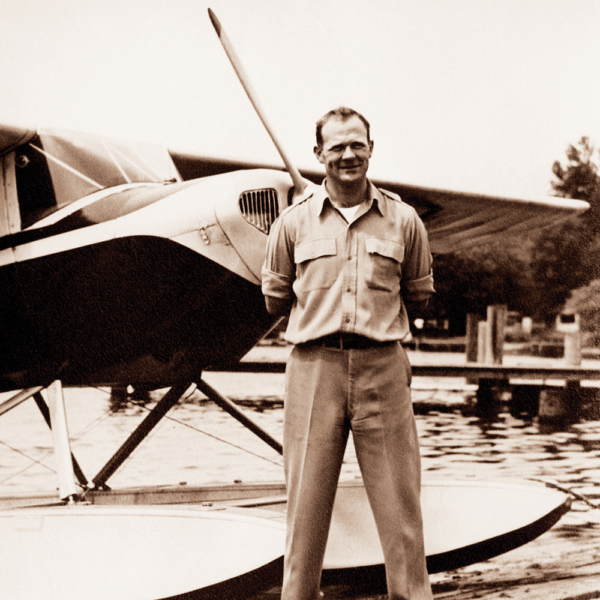History
With 25 aircraft in operation, 52 pilots on staff and more than 250 employees in peak season, Kenmore Air is among the best-known and most respected seaplane operations in the world. We fly an eclectic mix of piston de Havilland Beavers and turbine de Havilland Otters and Cessna Caravans, landing passengers on lakes, harbors, and tarmac among the mist-shrouded fjords and islands of the US and Canadian northwest.
Kenmore Air: 1996–Today
If Kenmore Air’s business took off from 1971 to 1996, the next chapter is when it came in for a landing.
In June 2004, Kenmore Air inaugurated landplane service, leasing one Cessna Caravan that flew the route to Port Angeles. This marked a significant step, providing all-weather service for both day and night commuters. The service was also less seasonal.
By July 2008, the landplane division christened Kenmore Air Express, was flying 60,000 passengers per year.
It was the next path in a path that Bob Munro had started back in 1946 when he and two men he knew in high school were working on a salvaged floatplane in a single garage.
Munro, who’d graduated from Seattle’s Roosevelt High School in 1935, married Ruth Holden in 1942, and they had raised a family there in Kenmore in a house located on the 5-acre campus that is Kenmore Air Harbor.
In 1997, he was inducted into the Pathfinder Hall of Fame at the Museum of Flight,
In 1999, he was inducted into the Washington State Aeronautics Hall of Fame.
Bob Munro died in October 2000, and while he stopped flying in the 1980s, he never retired, working at Kenmore Air throughout those 54 years. After he passed there was some question about what would happen with the business going forward. Wait. That’s not quite right. Some people had questions, but Gregg Munro and Leslie Banks, the children of Bob and Ruth Munro, kept the business open.
Gregg had worked his way up the business from flight operations manager in 1980 and later became president. Leslie Banks, Bob’s daughter, was working from her early teenage years and eventually managed the office, and her son Todd — Bob’s grandson — computerized the flight operations and upgraded the parts department computers as well.
Todd now serves as vice president of business development while his son Hunter started — as all members of the family do — with the entry-level duties like emptying the garbage, washing planes, and working the lines before becoming a Kenmore Air pilot.
Family runs deep at Kenmore Air. Clarence Rader started with Kenmore in 1946, and his son, Jerry, was later the company’s technical adviser while Steven, the grandson of Clarence, became a mechanic.
The business that Bob started would be guided by the next two generations of his family as it solidified itself not just as a business, but as a critical cog in the region’s transportation network. A critical cog that was also the coolest, now flying regular schedules as opposed to orienting itself around the charter business.
In 2018, family-owned Seattle Hospitality Group made a significant investment in Kenmore Air and in April 2023 David Gudgel took over as President and Seattle Hospitality Group is now a majority shareholder.
As a family-owned business that is more than 75 years old, the company still operates by the words of its founder, Bob Munro: “As long as we have the kind of people working for us that we’ve had since the beginning, there should be airplanes with ‘Kenmore’ on the side flying around this part of the world for a long time.”
Kenmore Air: 1970 − 1995
The business takes off
Bob Munro worked hard to get Kenmore Air off the ground. His daughter, Leslie, remembers there was a time he needed to sell an accordion in order to make payroll.
But if the first 25 years of the company’s history were marked by this ability to hold everything together, the next 25 years were when Kenmore Air reached a cruising altitude.
First, it continued to be a company counted on for finding enterprising solutions to specific tasks. In the 1970s, Kenmore Air had a year-round contract with the federal government to provide transportation among the naval bases in the Northwest. The payload ranged from torpedoes to admirals, and there was also a specific project that involved flying folks up to a U.S.-Canadian test facility off of Vancouver Island.
There was more glamorous cargo, too. John Wayne and Katherine Hepburn were among the passengers Kenmore Air flew out to the San Juan Islands. So were Goldie Hawn and Neil Armstrong, and Kenny G, Seattle’s very own saxophone player. He was a regular passenger until he went and bought his own plane and even that tells part of the story of Kenmore Air’s growth.
When Kenmore Air started in 1946, a big component of the business was flight instruction. Beginning in the 1970s, Kenmore Air built out the manufacturing side of its business to serve the boom in private plane ownership. And there was one plane in particular that Kenmore Air became known for: the de Havilland Beaver.
The aircraft was conceived and built in Ontario, Canada, its first flight was logged in 1947. Kenmore Air purchased its first Beaver in 1963 after Bob Munro tested the plane out on a customer’s suggestion.
The plane itself is a remarkable piece of engineering, often hailed as the best bush plane ever built. Kenmore Air took it the next step forward, thanks to that manufacturing department that was already mentioned. The Beaver is a single-engine workhorse that was designed to carry heavy loads into tight, sometimes rough, environments, and Kenmore Air applied its own ingenuity to make it even better. A new three-bladed prop was designed and manufactured, cutting down noise. It was also 50 pounds lighter. The original battery was not only replaced but repositioned, shaving off another 72 pounds while providing additional baggage space.
The Beaver has not been produced since 1967, but Kenmore Air has a well-earned reputation for not just maintaining but rebuilding, even resurrecting planes. They didn’t make them good as new, they made them so they were better.
In 1998, the actor Harrison Ford was filming “Six Days, Seven Nights,” a romantic comedy that also starred Anne Heche. There was a plane included in the film, which was originally supposed to be a Stinson Reliant. Ford, an avid pilot who took his first flying lesson in 1965, happened upon a de Havilland Beaver in Santa Monica, Calif., which belonged to John Nordstrom. Ford not only convinced the director that the Beaver was a better choice for the film, the actor decided he wanted one of his own. He was told that there was exactly one place he should consider getting it: Kenmore Air.
Ford’s plane started out as a rusted-out war veteran from the scrapyard that was brought back to life.
“It didn’t take me long to realize I was dealing with a very special company,” Ford said in ‘Success on the Step,’ a history of Kenmore Air. “My plane was doing the phoenix thing out in the shop, rising from the ashes of years of mistreatment and neglect to become a stunning example of the breed.”
Kenmore Air’s proficiency with the plane helped all aspects of the business, too, and the company didn’t just survive the consolidation that occurred within the industry, it began to thrive.
The growth could be counted in the aircraft, from 14 planes in June 1981 to 20 in August 1983 when Gregg Munro — Bob’s son — was president. Kenmore Air expanded beyond charter flights, beginning scheduled service in 1986.
In the 1980s, Kenmore Air bought out Otter Air, a smaller floatplane company that operated from Lake Union to Victoria Harbour in British Columbia. In January 1993, Kenmore Air acquired Lake Union Air Service, which was its primary seaplane competitor in the Seattle area. This included the purchase of the Lake Union terminal, which was relocated to include a new passenger waiting area and a new lighted awning.
What had started with a single floatplane in one garage on the site of an old shingle mill on the northern tip of Lake Washington had grown into a business that was taking off from the very heart of Seattle.
In 1995, Bob Munro was named the U.S. Seaplane Pilot of the Year by the Seaplane Pilots Association and awarded the Charles Taylor Master Mechanic Award by the FAA. The following year, when the company he founded celebrated its 50th anniversary, Kenmore Air had 22 seaplanes, a year-round staff of 85 people, and was flying 50,000 passengers a year a total of 2 million miles.
And as far as Kenmore Air had come in half a century, it would continue to push forward in the 25 years that followed.
Kenmore Air: 1947 − 1969
Northwest roots run deep at Kenmore Air
One of the largest, most successful seaplane operations in the world started with three high-school friends, one floatplane stuck in a lake, and a garage on the site of an old shingle mill.
The three friends were Bob Munro and Reg Collins — mechanics at Pan-Am — and Jack Mines, who returned in 1946 after serving as a pilot in World War II.
The plane was an Aeronca Model K, which was stuck in Lake Union. Munro and Collins paid $600 for the rights to salvage it.
The old shingle mill was on the north shore of Lake Washington, right off the Bothell Highway. The property included an outbuilding, a barn, and a two-story house.
Munro and Collins fixed up that Aeronca Model K out of their single garage. When Mines took it up for the first flight on March 21, 1946, someone driving by on Bothell Highway stopped to ask if flying lessons were available, and just like that, they were in the instructional business.
A lot has changed at Kenmore Air in the 75 years since that first flight in the two-cylinder, 36-horsepower Aeronca. The type of planes, the number of planes, the extent of service, and the growth of a thriving parts business. Two things have remained constant for Kenmore Air: the Munro family and meeting the needs of the customer.
Sometimes that’s very straightforward. Like when longtime Seattle Times outdoors columnist Enos Bradner called to see about getting up to Nahmint Lake — deep on Vancouver Island — to investigate the size of some steelhead he’d been hearing about. Munro had become as good of a pilot as he was a mechanic, and he flew Bradner and a photographer up to the lake in a four-seat Republic Seabee. The success of the fishing trip was the subject of Bradner’s next column with an accompanying picture that spurred an instantaneous demand for fishing charters.
In the early 1950s, a prospector named Tom McQuillan was looking to build a mining camp on LaDuc Glacier in Southeast Alaska, 50 miles east of Ketchikan. This was 1953, and McQuillan was looking to stake a copper claim on the Coast Range. Munro went up with fellow pilot Paul Garner along with McQuillan and an assistant. Munro landed that Republic Seabee directly onto the glacier without extending the retractable landing gear. McQuillan staked the claim, and Kenmore pilots subsequently flew a total of 194 round trips from March 19 to April 14, working from a floating camp anchored in Burrough Bay, using one Cessna and two Noorduyn Norseman “Thunderchickens.”
Munro made an art of landing floatplanes on the snow. In the summer of 1968, Kenmore Air began flying supplies into a research station on South Cascade Glacier, which was 70 miles northeast of Kenmore and getting data out. In the spring of 1970, he began doing the same for a University of Washington research station on the Blue Glacier, which spilled off the summit of Mount Olympus over on the Olympic Peninsula. The landing on Snow Dome was pretty straightforward, the take-off required the plane actually slide off the edge of the glacier and begin falling at a 45-degree angle before achieving take-off speed and bringing it up. You couldn’t exactly change your mind halfway through on that one!







